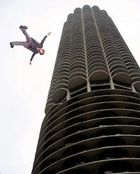Defenestration
Defenestration is a punishment that consists of the following parts:
- Lifting a person off of the ground.
- Throwing them out a window.
- Chuckling quietly, sometimes maniacally, and noting that justice has been served.
Origins[edit | edit source]
Archaeologists believe that defenestration was first practiced by the ancient Egyptians. In order to keep out the murdering heat and blinding sunlight, not to mention the aroma smell odour stench of decomposing camel dung, Pharaoh Syl-Via of the Tóth Dynasty decreed that all windows and other openings in his her palace walls were to be
sealed with brick and mortar. This unorthodox method of removing windows from buildings soon became quite popular and eventually led to the construction of the Greater and Lesser Pyramids. Unfortunately, after sealing the last window in the palace walls personally from the inside Syl-Via was never heard from again (though it is said that muffled cries where heard from within the building for some days after the ceremony).
Early pioneers[edit | edit source]
Defenestration began as an early failed attempt at manned flight. Renowned naturalist Sir Miles Plimpton hypothesized that human beings could fly if they were thrown out of a high enough window. In the ensuing experiments, all of Sir Plimpton's household staff ended up falling to their deaths somehow. It must be noted that Sir Plimpton did attempt to control the experiment by throwing household birds out of the window as well, though unfortunately he didn't release the birds from their cages and they too perished.
Years later his grandson Dr. Kilometers Plimpton attempted the same stunt, this time with bullfrogs and covalently bonded Hydrogen ions. Unfortunately, they melded together and created a superhero, The Covalent Bullfrog. He was later exposed to The Ionic Bullfrog so there on called The Metallic Bullfrog. Rumors later circulated that he was in an affair with Jennifer Aniston.
As punishment[edit | edit source]
Harold Crowley of Dorchester by the Sea first used defenestration as a theological legal argument against his cousin, Edgar, who he suspected of stealing a raspberry tart. Crowley famously said "If God wants you to fly, you will!", before chucking Edgar from the attic window of the family's stately house positioned on the edge of a 500-foot-high rocky cliff. Edgar shrieked what is believed to be a confession as he fell to a grisly death, and eyewitnesses swore in court that the tart was found with the body, although this evidence has been doubted by modern forensic experts. Nonetheless, legal precedent was immediately set and defenestration became an efficient short cut to the long lines at the London gallows.
Downfall[edit | edit source]
Unfortunately, few buildings in the 18th century were high enough to consistently kill a defenestration victim on impact. This was made especially difficult by the layers of filth and raw sewage that cushioned criminals' falls. The punishment was formally discontinued when a convicted mass murderer was thrown from Chancery only to sprain his ankle and limp through an additional vicious killing spree. At this point, one zealous barrister suggested shooting the criminals in the head and then throwing them out the window. This idea met with opposition on two counts 1) why throw the bodies out the window at all? and 2) the suggesting barrister represented the defendant. Before long, defenestration lost its legal justification and was pulled from the normal functions of the judicial system. However, the tradition continued as an underground punishment for knaves who were caught cheating at pinochle.
Resurgence[edit | edit source]
In modern times, defenestration enjoyed an exciting resurgence. Ambitious young college drunks have found new and innovative ways to self-defenestrate. In the 1936 Olympic Games in Berlin, defenestration was a team event held at the Reichstag in which competitors would see how many bureaucrats they could remove from the building in the allotted time. The favored technique was to seize them and push them through the nearest window; extra points were awarded for the use of props, such as showers of paper, tying to furniture, or the use of fire. The process has become so popular that there is currently a petition circulating to have it added to the 2008 Summer Olympic Games, which will be held, fittingly, in Beijing, China. If the petition is accepted, it will be the first time people have been thrown from windows there since the defenestration boom surrounding the Cultural Revolution.
The word "defenestration" has also gained the connotation of uninstalling Microsoft Windows from your computer and installing a better alternative operating system, such as OS/2, MS-UNO or Linux. The term was coined in the days of Windows 95 when the only way to correct some of the flaws inherent in Windows was to pick up your computer and throw it out the nearest window and go out and buy an Apple Macintosh. This is becoming popular again due to Windows XP which has similar flaws and is almost as useless. The next version of Windows, currently called Vista is reported to be so bloated that it can no longer be defenestrated in the usual manner, first the computer must be compressed, a 12 pound hammer is recommended. However, Apple has some of the same problems. The best way for one to accelerate their Mac is also at 9.8 meters per second squared. If you are consistently forced to defenestrate your computer, you may want to just revert to the stone age, where rocks solve everyone's problems.
Legacy[edit | edit source]
Ever since there were windows and there were dreams, there was a spark. That spark was defenestration. That ambitious calling that this window, no matter what story it was on, could be more than a simple window. The open window sings inspiring songs to the dreamer. It could be a portal to magical possibility that some day people would be thrown from that window. Today that dream is a growing reality, and many people aren't waiting around to be thrown out of windows. They are throwing themselves out of windows. It all proves that the inspiration to defenestrate is really the most irresistible inspiration there is.


